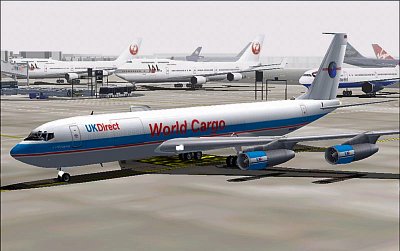Desktop Backgrounds Pictures Biography
Name: Boeing 707
First flight: December 20, 1957
The Boeing 707 is a mid-size, narrow-body four-engine jet airliner built by Boeing Commercial Airplanes from 1958 to 1979. Its name is commonly pronounced as "Seven Oh Seven". Versions of the aircraft have a capacity from 140 to 189 passengers and a range of 2,500 to 5,750 nautical miles (4,600 to 10,650 km).
Developed as Boeing's first jet airliner, the 707 is a swept-wing design with podded engines. Dominating passenger air transport in the 1960s and remaining common through the 1970s, the 707 is generally credited with ushering in the Jet Age. Although it was not the first jetliner in service, the 707 was the first to be commercially successful. It established Boeing as one of the largest manufacturers of passenger aircraft, and led to the later series of aircraft with "7x7" designations. The later 727, 737, and 757 share elements of the 707's fuselage design.
The 707 was developed from the Boeing 367-80, a prototype jet aircraft first flown in 1954. A larger fuselage cross-section and other design modifications resulted in the initial production 707-120, powered by Pratt & Whitney JT3C turbojet engines, which first flew on December 20, 1957. Pan American World Airways began regular 707 service on October 26, 1958. Later derivatives included the shortened long-range 707-138 and the stretched 707-320, both of which entered service in 1959. A smaller short-range variant, the 720, was introduced in 1960. The 707-420, a version of the stretched 707 with Rolls-Royce Conway 508 turbofans, debuted in 1960, while Pratt & Whitney JT3D turbofans debuted on the 707-120B and 707-320B models in 1961 and 1962, respectively.
The 707 has been used on domestic, transcontinental and transatlantic flights, and for cargo and military applications. A convertible passenger-freighter model, the 707-320C, entered service in 1963, and passenger 707s have been modified to freighter configurations. Military derivatives include the E-3 Sentry airborne reconnaissance aircraft and the C-137 Stratoliner VIP transports. During the 707's production run, Boeing produced and delivered a total of 1,011 aircraft, including the smaller 720 series. Over 800 military versions were also produced. As of August 2011, 10 examples of the Boeing 707 were in airline service.
Development[edit] Model 367-80 originsMain article: Boeing 367-80
During and after World War II Boeing was known for its military aircraft. The company had produced innovative and important bombers, from the B-17 Flying Fortress and B-29 Superfortress, to the jet-powered B-47 Stratojet and B-52 Stratofortress. The company's civil aviation department lagged far behind Douglas and other competitors, the only noteworthy airliners being the Boeing 314 Clipper and 307 Stratoliner. During 1949–1950, Boeing embarked on studies for a new jet transport, realizing that any design must be aimed at both the military and civil markets. At the time, aerial refueling was becoming a standard operational technique, with over 800 KC-97 Stratotankers on order. With the advent of the jet age, a new tanker was required to meets the USAF's fleet of jet-powered bombers; this was where Boeing's new design would potentially win military orders.
Boeing studied numerous wing and engine configurations for its new transport/tanker, some of which were based on the B-47 and C-97, before settling on 367–80. The "Dash 80" took less than two years from project launch in 1952 to rollout on May 14, 1954, then first flew on July 15, 1954. It was powered by the Pratt & Whitney JT3C turbojet engine, which was the civilian version of the J57 used on many military aircraft of the day, including the F-100 Super Sabre fighter and the B-52 bomber. The prototype was conceived as a proof of concept aircraft for both military and civilian use. The United States Air Force was the first customer for the design, using it as the basis for the KC-135 Stratotanker midair refueling platform.
It was far from certain that the passenger 707 would be profitable. At the time, Boeing was making nearly all of its money from military contracts: Its last passenger transport, the Boeing 377 Stratocruiser, had netted the company a $15 million loss before it was purchased by the Air Force as the KC-97 Stratotanker. In a demonstration flight over Lake Washington outside of Seattle, on August 7, 1955, test pilot Tex Johnston performed a barrel roll in the 367-80 prototype.
Boeing 707-123B cockpitThe 132-inch (3,350 mm) wide fuselage of the Dash 80 was large enough to only fit four-abreast (two-plus-two) seating (in the manner of the Stratocruiser). Answering customers demands and under Douglas competition, Boeing soon realized that this would not provide a viable payload, so decided to widen the fuselage to 144 in (3,660 mm), the same as the KC-135 Stratotanker, which would allow five-abreast[disputed – discuss] seating—and the shared use of the KC-135's tooling. However, Douglas Aircraft had launched its DC-8 with a fuselage width of 147 in (3,730 mm). The airlines liked the extra space and six-abreast seating, and so Boeing was obliged to increase the 707's width again to compete, this time to 148 in (3,760 mm).
Desktop Backgrounds Pictures
Desktop Backgrounds Pictures

Desktop Backgrounds Pictures



Desktop Backgrounds Pictures
 Desktop Backgrounds Pictures
Desktop Backgrounds Pictures


Desktop Backgrounds Pictures

Desktop Backgrounds Pictures

Desktop Backgrounds Pictures
%20-%20Wallpapers4Desktop.com%20008.jpg)
Desktop Backgrounds Pictures

Desktop Backgrounds Pictures
 Desktop Backgrounds Pictures
Desktop Backgrounds Pictures


Desktop Backgrounds Pictures

Desktop Backgrounds Pictures

No comments:
Post a Comment